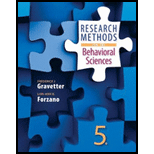
Concept explainers
Describe tenacity and intuition as methods of knowing or acquiring knowledge. Identify an example and explain the limitations of each method.
To describe:
Tenacity and intuition as methods of knowing and acquiring knowledge and identify an example and limitation of each method.
Answer to Problem 1LO
Solution:
Tenacity is defined as the one of the most common and dangerous method of accepting new information.
Intuition is defined as the belief that whatever they answer that is true without any evidence.
Explanation of Solution
There are various methods of knowing or acquiring knowledge: tenacity, intuition, authority, the rational method and the empirical method. Tenacity is one of the most commonly used method which tells that the truth is true even when the evidence contradicts whereas the intuition is the method in which believe or guess of a person is considered without any evidence. The limitation to tenacity method is that it is strong in terms of belief even in the presence of proof/evidence. Therefore this method might not be accurate. The intuition is a good
as it supports us to develop our confidence but sometimes it is harmful because intuition may not be right always as there are evidences available against the intuition but one does not believe as he/she may be overconfident about that.
Conclusion:
Tenacity and intuition are the methods for acquiring knowledge. Tenacity is the method in which truth is considered as true even if the evidence is against in that truth whereas the intuition means believe or guess in the absence of evidence.
Justification:
As the tenacity tells that the truth is true even if there is absence of support in terms of evidence such as in the research work, if our research is true and evidence, that is, another research paper is in against of our research paper, we consider that our research is correct. In some competitive examinations, sometimes the options given for the particular question may not correct then, in that case, one ticks the correct option on the basis of his/her intuition.
Want to see more full solutions like this?
Chapter 1 Solutions
Research Methods for the Behavioral Sciences (MindTap Course List)
 Glencoe Algebra 1, Student Edition, 9780079039897...AlgebraISBN:9780079039897Author:CarterPublisher:McGraw Hill
Glencoe Algebra 1, Student Edition, 9780079039897...AlgebraISBN:9780079039897Author:CarterPublisher:McGraw Hill Mathematics For Machine TechnologyAdvanced MathISBN:9781337798310Author:Peterson, John.Publisher:Cengage Learning,
Mathematics For Machine TechnologyAdvanced MathISBN:9781337798310Author:Peterson, John.Publisher:Cengage Learning, Big Ideas Math A Bridge To Success Algebra 1: Stu...AlgebraISBN:9781680331141Author:HOUGHTON MIFFLIN HARCOURTPublisher:Houghton Mifflin Harcourt
Big Ideas Math A Bridge To Success Algebra 1: Stu...AlgebraISBN:9781680331141Author:HOUGHTON MIFFLIN HARCOURTPublisher:Houghton Mifflin Harcourt Intermediate AlgebraAlgebraISBN:9781285195728Author:Jerome E. Kaufmann, Karen L. SchwittersPublisher:Cengage Learning
Intermediate AlgebraAlgebraISBN:9781285195728Author:Jerome E. Kaufmann, Karen L. SchwittersPublisher:Cengage Learning Algebra for College StudentsAlgebraISBN:9781285195780Author:Jerome E. Kaufmann, Karen L. SchwittersPublisher:Cengage LearningAlgebra & Trigonometry with Analytic GeometryAlgebraISBN:9781133382119Author:SwokowskiPublisher:Cengage
Algebra for College StudentsAlgebraISBN:9781285195780Author:Jerome E. Kaufmann, Karen L. SchwittersPublisher:Cengage LearningAlgebra & Trigonometry with Analytic GeometryAlgebraISBN:9781133382119Author:SwokowskiPublisher:Cengage





